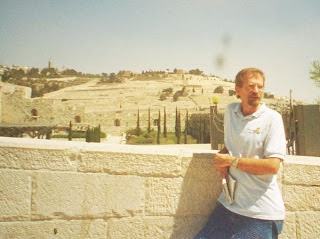Welcome to the online home of JCC BIB 100 for my Mon/Wed classes, Fall 2011
1)Welcome
Greetings!
My name is Dave, and I'll be your teacher for this amazing class that everyone at FPU takes in some form or another... I have been praying for you, and look forward to meeting you.
Here I am in Israel, a place I always am ...in spirit.
But there's really no place I'd rather be than with you
all, as we study together "Jesus and the Christian Community.
You will probably want to have a digital or printed version of the syllabus with you in class tomorrow, as we will walk through it. Find it by clicking the "syllabus/assignments" tab at the top of this page,
I know some may be a bit freaked out about this class, but I really think it will surprise you how much you enjoy it It might even change your life....like it did when I took it as a freshman here in 1982 (See photo of me wring a paper for this class on something called a "typewriter"):
This website is set up in blog format, and I will update it
after every class session with some notes and summaries of what we've done, as well as any available videos we have shown in class. You'll want to check here frequently.
Feel free to let me know anything I can do for you, and any way I can pray for you.
My contact info is above.
Blessings,
Dave
--
2)Intro to "Three Worlds"
The course addresses "Who is Jesus in Matthew" through the lens of what Hauer and Young call the "Three Worlds" of the Bible. A quick introduction below, and click here for more helpful detail (both from Tessa Brolin website):
Literary World--The literary world of the Bible is simply the text itself, apart from anything outside the text. We mean the world (or, better, worlds) created by the text; the words on the page, by the stories, songs, letters and the myriad other types of literature that make up the Bible. All good literature (and the Bible is, among other things, good literature) creates in readers' minds magnificent, mysterious, and often moving worlds that take on a reality of their own, whether or not they represent anything real outside the pages (Hauer and Young ch 2).
Historical World--The historical world of the Bible is the world "behind the text" or "outside the text". It is the context in which the Bible came to be written, translated, and interpreted over time, until the present. In studying the historical world of the Bible, we look for evidence outside the text that helps us answer questions such as, who wrote this text, when was it written, to whom was it written, and why was it written. We also probe the text itself for evidence that links it to historical times, places, situations, and persons (Hauer and Young 2)..
Contemporary World--The contemporary world is the "world in front of the text" or the "world of the reader." In one sense, there are as many contemporary worlds of the Bible as there are readers, for each of us brings our own particular concerns and questions to the text. They inevitably shape our reading experience. We are all interested in answering the questions of whether the Bible in general, or particular texts, have any relevance to our personal lives (Hauer and Young ch3).
-Brolin
----------------------
3)TEXTS:
what's a text? "any message, through any medium, designed to communicate" Here is the opening video I'll show in class today...without giving any advanced context.
We then listed how it made you feel, and suggestions for genre of the film (Or "text").
Words like "irony," "satire," came up...we then suggested all the descriptions you used were definitions of "parable," ....and the need to discren context, since it takes a minute to get the text and context of the video.
 Summarizing the "Three Worlds" from today's reading...We covered a lot of ground today, talking about TEXTS.
Summarizing the "Three Worlds" from today's reading...We covered a lot of ground today, talking about TEXTS.Here's some of it.
 TEXT ME DURING CLASS>>>559.974.2508
TEXT ME DURING CLASS>>>559.974.2508By the way, if you miss class today, you better ask someone about the "Butt cheeks" story (;
Suffice to say that commas (and context) matters..
Like this one:
How you read the text changes as much as everything.
Spaces matter.
Like this:
Professor Ernest Brennecke of Columbia is credited with inventing a sentence that can be made to have eight different meanings by placing ONE WORD in all possible positions in the sentence:
"I hit him in the eye yesterday."
The word is "ONLY".
The Message:
1.ONLY I hit him in the eye yesterday. (No one else did.)
2.I ONLY hit him in the eye yesterday. (Did not slap him.)
3.I hit ONLY him in the eye yesterday. (I did not hit others.)
4.I hit him ONLY in the eye yesterday. (I did not hit outside the eye.)
5.I hit him in ONLY the eye yesterday. (Not other organs.)
6.I hit him in the ONLY eye yesterday. (He doesn't have another eye..)
7.I hit him in the eye ONLY yesterday. (Not today.)
8.I hit him in the eye yesterday ONLY. (Did not wait for today.)-link
Like this 'text message' from Jesus:
I SAY TO YOU TODAY, "YOU WILL BE WITH ME IN PARADISE.'
or is it,
I SAY TO YOU, " TODAY YOU WILL BE WITH ME IN PARADISE."
The original manuscripts of the Bible not only run all letters, all caps, together, but include no punctuation.
Punctuation matters.
Everything is context.
Context is everything.






Feel free to add comments or ask questions in the "comments" section at the bottom of every post.
ReplyDeleteIf you don't have an account to post with, just sign in as "Anonymous"